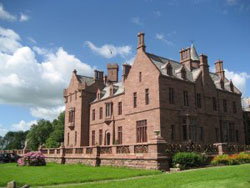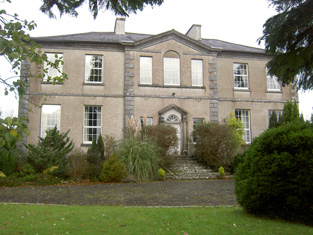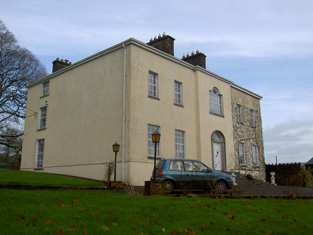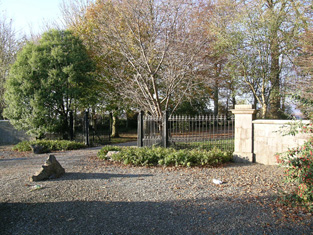Darragh House
Houses within 10km of this house
Displaying 23 houses.
Houses within 10km of Darragh House
Displaying 23 houses.
| House name | Description | |
|---|---|---|
| Castle Oliver | The original Castle Oliver or Clonodfoy was the home of the Oliver family in the 18th and early 19th centuries. It was replaced by the present building in the mid 19th century. In 1814 Castle Oliver was occupied by George Fosbery who may have been employed by the Olivers. In 1837 Lewis described the castle as being in a very dilapidated state. It then belonged to R. O. Gascoigne of the county of York whose bailiff resided in it. The new building was designed by George Fowler Jones and built in the Scottish baronial style for the Oliver Gascoignes. At the time of Griffith's Valuation the castle was valued at £75 and the house at £48 and both were in the possession of Elizabeth O. Gascoigne and her brother-in-law, Frederick Charles Trench. The house was eventually inherited by Elizabeth's step-grandson, William Cosby Trench. He was the occupier in 1906 when it was valued at £125. Restored in the early 21st century it now provides self catering accommodation and is a venue for functions such as weddings. |

|
| Ahnagurra | Ahnagurra was the residence of Thomas T. Adams in 1837 and at the time of Griffith's Valuation, when the buildings were valued at £26. He held the property from Francis Coppinger. | |
| Ballynalacken | A house valued at £15 and occupied by George Gubbins who held it from Francis Coppinger at the time of Griffith's Valuation. It is no longer extant. | |
| Griston House | The residence of a branch of the Massy family, occupied by Frederick Massy in 1814. Described by Lewis in 1837 as the fine old family mansion of the Masseys. Fitzgerald writes that Charles Massy of Griston was a brother of Lord Massy and 1st Lord Clarina. At the time of Griffith's Valuation it was valued at £12 and occupied by Michael McMahon, who held it from Charles O'Brien Massy. | |
| Ballynacourty | In 1837 and at the time of Griffith's Valuation occupied by Michael Burke. In the 1850s it was valued at £13 and held from the Honourable C.B. Wandesforde. | |
| Massy Lodge | This house is named Massy House on the first Ordnance Survey map and was the main residence of Lord Massy in the first decade of the 19th century. In 1814 Anglesborough was occupied by Hugh Toutstone [Touchstone]. Lewis describes Massy Lodge as the elegant residence of Lord Massy. At the time of the first Ordnance Survey Massy Lodge was the residence of Robert Harding. It was held by Lord Massy in fee at the time of Griffith's Valuation and valued at £24+. The partly demolished house is now owned by the Hanly family. |

|
| Bosnetstown | The Bennett family were resident at Bosnetstown from the early 19th century. Charles Bennett of Bosnetstown was a coroner for county Limerick in the 1810s. Located on the estate of Lord Lisle this house was occupied by George W[heeler] Bennett in 1814 and 1837 and in the early 1850s by George Bennett. The property was valued at £14. In the 1870s George Wheeler Bennett of Kilfinane held 156 acres in the county. The Bennett also lived in other houses closeby at various times for example Kilfinane House. http://members.iinet.net.au/~nickred/trees/bennett.pdf | |
| Spa Hill | A home of the Oliver family, occupied by Charles Deane Oliver in 1814 and by William Oliver in 1837 and at the time of Griffith's Valuation. The buildings were valued at £23+ and William held them from the Trench/Gascoigne estate, with a corn mill. |

|
| Sunville | A residence of the Godsell family in the 18th century, it was still in the possession of James Godsill in 1814. Lewis writes that Sunville anciently belonged to the Godsall family but was "now" (1837) the residence of E. Sayers. Edward Sayers held it in fee at the time of Griffith's Valuation. Sunville/Sunvale was afterwards a residence of the Low family, being occupied in 1906 by Colonel John Low. Lithographs of this house and mill are included in the sale rental of 1853. The Irish Tourist Association surveyor wrote in 1943 that the house was owned by Mr John O'Donnell. He says that it was built in the early 18th century by the Cosby family from whom it passed to the Lowes. It is labelled Sunvale on the 25-inch Ordnance Survey map of the 1890s. The house is no longer extant. |

|
| Ballyenahan | A house on the Hyde estate inhabited by the Welsh, Kearney, Spratt, Greene and Barry families in the late 18th and 19th centuries. Wilson, writing in 1786, refers to it as the seat of Mr. Walsh. Eliza Greene was the occupant at the time of Griffith's Valuation when the buildings were valued at £18. The Barrys owned this house until the late 20th century. |

|
| Graig | Built by the Hill family, probaby in the last decade of the 18th century, this house was their main home throughout the 19th century. Occupied by James Hill in 1814 and 1837 and by Arundel Hill in the early 1850s. The buildings were valued at £25. By the mid 1870s the head of the Hill family was resident at Mount Southwell. Graig was restored in the 20th century. |

|
| Bowen's Court | Built in the 1770s by Henry Cole Bowen this house was the seat of the Bowen family until 1959 when it was sold by the author Elizabeth Bowen. Wilson, writing in 1786, refers to it as Faraghy, the seat of Mr. Cole Bowen. It was held in fee by Mrs. Eliza Bowen at the time of Griffith's Valuation, when it was valued at £75. In 1942 the Irish Tourist Association Survey noted that the house had been attacked during the 1798 rebellion. Bowen's Court was demolished in 1961. |

|
| Meadstown | Burke's ''Landed Gentry of Ireland'' (1904) records the Franks family of Maidstown, county Cork. Hajba dates the present house circa 1860 replacing an earlier house. At the time of Griffith's Valuation the Reverend James Golden occupied Meadstown which he held from Henry Franks. The buildings were valued at £10.15 shillings. This house is still occupied. | |
| Springvale | This house was ccupied by Roger Bourke in 1814 and by Roger S. Bourke in 1837. Roger Burke was married to a sister of Garret Nagle of Ballinamona. William Baily was resident in the early 1850s and held the property from the Earl of Kingston. The buildings were valued at £14.10 shillings. Grove White writes that Springvale was purchased by George Grehan of Clonmeen in 1855 and John J. Therry, his agent, lived there. In 1942 the Irish Tourist Association noted it as the residence of Mrs. Helen Clancy, a descendent of Therry. Although abandoned for some years in the 20th century the house has now been restored and is lived in again. |

|
| Rockmills Lodge [Rockmills House] | The lodge was the residence of Colonel Richard Aldworth in 1814. Hajba writes that it was built as a shooting and fishing lodge by Colonel Richard Aldworth in 1776 and that he left the property including the mills to his wife's nephew, Charles Deane Oliver (grandson of Robert Oliver of Cloghanodfoy). Occupied by Mrs Sarah Oliver in 1837 and at the time of Griffith's Valuation and held by her from the representatives of Bond Lowe. The buildings were valued at £25 and she was leasing a flour mill and other buildings valued at £170 to P.L. Lyster. This property was advertised for sale in June 1856. The house was burnt in May 1921 during the War of Independence when it was the residence of Charles Deane Oliver. In 1942 the Irish Tourist Association Survey noted that it had been rebuilt by the Walsh family and was then (1942) occupied by the Casey family. It is still extant. The mills are now in ruins. |
![Photo of Rockmills Lodge [Rockmills House]](https://landedestates.ie/storage/img/orig/1591.jpg)
|
| Mitchelstown Castle | The original castle belonged to the FitzGibbons, the White Knight. It passed through the marriage of Margaret FitzGibbon and Sir William Fenton to the heirs of their daughter, Catherine, and her husband, Sir John King. By the mid 18th century the Kings had replaced the castle by a house which was altered and extended over the years. In 1786 Wilson refers to it as "the very magnificent seat of Lord Kingsborough". In the 1820s the 3rd Earl built a new castle in anticipation of a visit from George IV which never happened. This was a huge building in the Gothic Revival style, valued at £180 in the mid 19th century. It remained in the possession of the Kings until the death of Lady Kingston, widow of the 5th Earl. In 1922 the castle was looted and burnt and the stones were later used to build a church at Mount Melleray. In 1943 the Irish Tourist Association Survey provided a detailed description of the castle and its history and noted that portion of the cellars and foundations were still visible. |

|
| Marshalstown | This house was known as Castle Eugene in 1837 when it was the home of Eugene O'Neill, medical doctor. Dr O'Neill was still resident in the early 1850s when the house was valued at £41.10 shillings and held from the Earl of Kingston. This house no longer exists. | |
| Mounteagle Cottage | Hajba writes that this was a sporting lodge of the Earls of Kingston. In the early 1850s it was occupied by Thomas O'Brien and valued at £14.10 shillings. It is still a residence. | |
| Killee | The seat of the Montgomery family from the mid 18th century, occupied by George Montgomery in 1814 and by William Quinn Montgomery in the early 1850s. It was held in fee at this time and valued at £43. Killee remained in Montgomery possession until the 1930s. It is still occupied. |

|
| Broomhill | Valued at £11, occupied by James Geran and held from James N. Cronin at the time of Griffith's Valuation. Later the home of a member of the Montgomery family and still inhabited. | |
| Cloonkilla | James H. Mandeville held buildings valued at £21 from James N. Cronin among the woods at Cloonkilla at the time of Griffith's Valuation. | |
| Stannard's Grove | Located on the Cotter estate, this house was occupied by the Stannard family at the end of the 18th century. It was later occupied by the Adams and Smith families. Lewis records it as unoccupied and at the time of Griffith's Valuation it was held in fee by Edward Cotter. The home of William Stackpool at the beginning of the 20th century. Hajba writes that the house was reconstructed in 1924 after been blown up in 1921 by the British Crown Forces. In 1942 the Irish Tourist Association Survey noted that it had, since 1934, been owned by the Herlihy family. It is still extant. |

|
| Aghacross | Wilson, writing in 1786, refers to Aghacross as the seat of Mr. Anderson. No substantial residence is shown in this area on the 1st edition Ordnance Survey map. The townland was in the possession of William Anderson at the time of Griffith's Valuation. A modern farm exists at the site now. |

